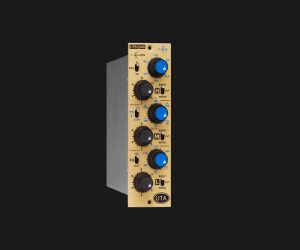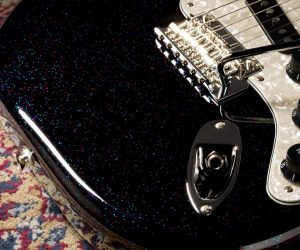
East of Everything
‘Travelling North to Possum Creek’ sounds like a musical journey before it’s even begun. Pack your twangers, we’re off!
SOUND & MUSIC FROM A NORTHERN NSW ODYSSEY
Text: Greg Walker
Last winter I’d battened down the hatches, ready for everything South Gippsland’s notoriously wet and cold climate had to throw at me. I’d patched up a few cracks in the floorboards and lined up enough recording projects to pay for the heating bills, so I was reasonably set. Then, out of the blue, I got a call to compose and record the music for East Of Everything – a new TV show set in Byron Bay and shot in and around the Byron area. Suddenly everything changed.
Saying ‘yes’ to this job would somehow mean creating a huge new chunk of time in my schedule, relocating to Northern NSW for three months and taking my entire studio and family with me. Just to raise the degree of difficulty even further, I’d have to be up there and ready to start work in two weeks. Well, I’d be lying if I said it was a tough decision to make. So, somewhat miraculously, within about 10 days, my wife Karen, our one-year-old son Marley and I were burning rubber up the east coast. In tow was our newly purchased second-hand trailer with every nook and cranny in both it and the station wagon jammed with as many recording devices, musical instruments and worldly possessions as we could possibly fit.
LAY OF THE LAND – LESSONS IN BEING FLEXIBLE
Due to space and time restrictions, we hurriedly rented a furnished house with the usual special requirements: no nearby neighbours, surf beaches, busy roads or other noise sources such as generators, tractors, panel beating workshops etc. We were also hoping to get a house with an adjoining studio/workshop type scenario so that there could be a ‘mutually beneficial’ degree of separation between the family and I. In the week before we left home we found a place on the Net that looked very promising. It had a pretty two-bedroom timber cottage and an additional two-story ‘studio’, which looked kind of small on the web thumbnails, but I convinced myself it would be a workable space if the gear was split between the two stories. The place was in Possum Creek, out the back of Bangalow but still within striking distance of the TV show’s production office in Byron. In amongst regenerating native bushland on 40 acres it looked beautiful and was the best place we could find at such short notice, so we paid our deposit and crossed our fingers.

CROSSING THE THRESHOLD
As we drove into the driveway on a crystal clear morning in early June we were excited to see how beautiful and peaceful the area was and how great our cottage looked. Then I got my first look at the ‘studio’. Turns out it was actually really small, as in not-being-able-to-set-a-drum-kit-up-in small and I quickly realised that I’d have to somehow work in the house. Fortunately, the house had two distinct sections to it and I was able to set up the main recording space and control room in one of the upstairs bedrooms, with access to the lounge room below. Upstairs had a steeply pitched gabled pine board ceiling that made it sonically a little odd and closed-in but I figured I’d have to make the best of it (at least it was wood). At least I could do my work facing the big circular leadlight window at the end of the room and the forest view beyond it.
My main problem was (surprise, surprise) computer fan noise, as there were no doors and way too many open spaces (including a stairwell) between the upstairs and downstairs areas. So I reverted to an old and trusted method of yore and stuck the computer out the window and onto the roof. The roof got a lot of sun in the early morning so I tended to keep the computer inside and mix until a little later in the day. I also had to remember to bring it in during rainstorms (though there was precious little rain the whole time we were there – it was all falling in South Gippsland).
WORDS & MUSIC – LESSONS IN PREPAREDNESS
Once I’d got my setup pretty much in place I could turn my attention to the brief and read up on the script. The basic story centres on the return of the main character Art Watkins to ‘Broken Bay’ after a long absence and his attempts to reconcile himself with the people he left behind, particularly his estranged girlfriend, his son and brother. The script touches on many facets of the Byron Bay experience, from its spirituality to its blatant commercial aspects; indigenous issues through unplanned pregnancy to real estate and the many subplots weave a rich fabric of human relationships that draws the viewer in.
Being shot on location around the Byron shire there is also a very strong visual sense of place that the music had to respond to. I met up with producer Fiona Eagger, director Stuart McDonald, the screenwriters, editors, post production and music supervisors and we discussed the kind of role we wanted the music to play and the type of textures we were looking for. The music had to be essentially organic but I was determined to take it away from the generic acoustic blues/roots style that often gets associated with the Northern Rivers area, and go for something a bit more sonically eclectic and distinctive. Fortunately, I’d brought up a good collection of acoustic instruments including my trusty Erhu (Chinese violin), violas, violins and lots of bells and other hand percussion as well as electric guitars and an amp, a drum kit and an electric bass. I also had an Akai sampler loaded up with percussion and keyboard sounds and was able to borrow a number of kooky stringed instruments from the show’s art department including a flea-bitten Tibetan Drangen and a banjo lute.
I reverted to an old and trusted method of yore and stuck the computer out the window and onto the roof
UKES & OUT-TAKES
Perhaps the most significant thing I did early on was to buy a cheap ukelele from the local music shop. This ended up being the bedrock of much of the music score – being somewhat light and off-beat in tone and allowing plenty of space for other instrumental overdubs around it. Another thing I did, that I would recommend to anyone going into the music for film and TV game, was hand over a quantity of instrumental recordings, such as album out-takes, unused bits from other soundtrack jobs and other old recordings. This gave the director and editor some stuff to work with straight out of the box and got them used to my style. It also meant that if the dreaded ‘temp-music syndrome’ arose, the work was already done or I’d at least be copying myself rather than somebody else. I also recorded some stuff straight away before editing had even started to get things stylistically into the right ballpark – a couple of these pieces made it through to the final product, although most didn’t.
GETTING THE SOUNDS – LESSONS IN SIMPLICITY
I ended up tracking all the music on a ProTools 001 rig (my 002 had a nervous breakdown right at the get-go. Luckily, I brought my old rig along as back-up). All the conversion was done with an RME ADI-8 DS and monitoring was through Genelec 8240As (see the Genelec review in Issue 55). I recorded most of the ukes, guitars and other twangers with a stereo setup using a Neumann U87 and an AKG 451 through a Universal Audio 6176 and a Chandler Channel MkII, each time working the placements until the two mics were relatively tonally balanced. Generally, I put these mics around two to three feet away, pointing just behind the sound hole and where the neck meets the bridge. This setup worked really well and I returned to it time and time again as a default setting. It was important to have a simple, recallable setup for basic tracking when I had to re-record or change sections of an existing piece. I put my Fender amp downstairs in the larger room and close-miked it with either a Shure SM57 or a Sennheiser MD441 and I found a great spot for the 451 as a room mic halfway up the stairs in the opposite corner of the room. All the strings were done with the Neumann, either through the UA 6176 or an HHB Radius channel strip. Samples and other keyboard sounds went direct into a Universal Audio 2108 – a great D.I. for these kind of stereo applications. When I did finally break out the drum kit I used two AKG 451s for overheads, the U87 for a compressed room mic, a Shure SM57 on snare and SM58s and the MD441 on toms. For the kick I used a very cheap Leem SR105 that sounded quite good when it had no real right to. For percussion I generally used the 451 through the Chandler for extra passive EQ fizz. Once I had the sounds in the box my go-to plug-ins were the McDSP filterbank EQs and compressors, the Bomb Factory 1176 compressor emulation and the T-Racks mastering plug-in for mix bus compression and final EQ.
weeks quickly turned into months in a haze of salt water, ukeleles and rapidly closing deadlines

OTHER ROLES – LESSONS IN THE MALLEABILITY OF FUNCTION
It’s a basic fact of composing for film and TV that at least half of what you write won’t get used. In a show like this where there’s lots of face-to-face contact with directors, the producer and other ‘stakeholders’ in the creative process, that ratio tends to go south even more. It’s therefore crucial to embrace the collaborative nature of the endeavour and to develop a thick skin and large reserves of patience in order to deal with critical reviews of your work and the need to reload on certain scenes. While you might feel you’ve nailed the music, there’s a bigger vision at stake and sometimes you have to revisit the tempo, texture or arrangement to find the right emotional ‘fit’ for the scene.
The first episode of the show proved to be the most time consuming in this regard, involving lots of trial and error to develop the styles and sounds we would then use throughout the series. Certain characters had to have themes written for them that were both distinctive and revealed something about them on an emotional level. Once we’d evolved the ‘house style’ of the show the episodes (and the deadlines) quickly stacked up. On a second front I had to rework an old song of mine for the title track; turning it from a five-minute epic into a one-minute pop nugget. There was also more music required for the promotional trailer. Meanwhile, I’d also been co-opted into becoming a guitar teacher and musical director to some of the actors for several scenes involving the characters jamming together. And by Episode 5 even I ended up on screen playing a ‘musician in a wine bar’ singing a Tex Perkins song to Suzie Porter and Leah Vandenburg and a bunch of extras! The sound for this track was pre-recorded by Grant Shepard and his team using a simple setup of an SM58 on vocals and SM57 on guitar (see Grant’s sidebar for more info on his location recording gear). By this time I’d also succumbed to the lure of surfing Lennox Head at every available opportunity and the weeks quickly turned into months in a haze of salt water, ukeleles and rapidly closing deadlines.
I also had the opportunity to record and work with some great local artists including the amazing Tibetan singer Tenzin Choegyal, singer-songwriter Sara Tindley and percussionist extraordinaire Greg Sheehan (having temporarily moved our entire operation one hour north to the Gold Coast hinterland while our landlady made a fortune during the Splendour In The Grass weekend).
HEADING SOUTH
By late August the music approval meetings had gone from eight- or nine-person chinwags to just me and the producer going through the final episodes. With the last of the recording done we promptly packed up all our stuff and, with many a backward glance, headed for home. We had a great time in Byron Shire. The whole family made many new friends and we fell in love with the region – as every sane person does – so it was a little hard to leave. I guess when we want to relive our time up there we can just rent out East Of Everything on video and it’ll come back pretty quickly. It was certainly one of the most all-encompassing projects I’ve ever worked on and an absolute hoot from start to finish but it was good to get back home. We’d gone from pretty much the southernmost point of mainland Australia to the Easternmost point and back again. Now all I had to do was spend the next six months catching up on all those stalled winter projects…
















RESPONSES